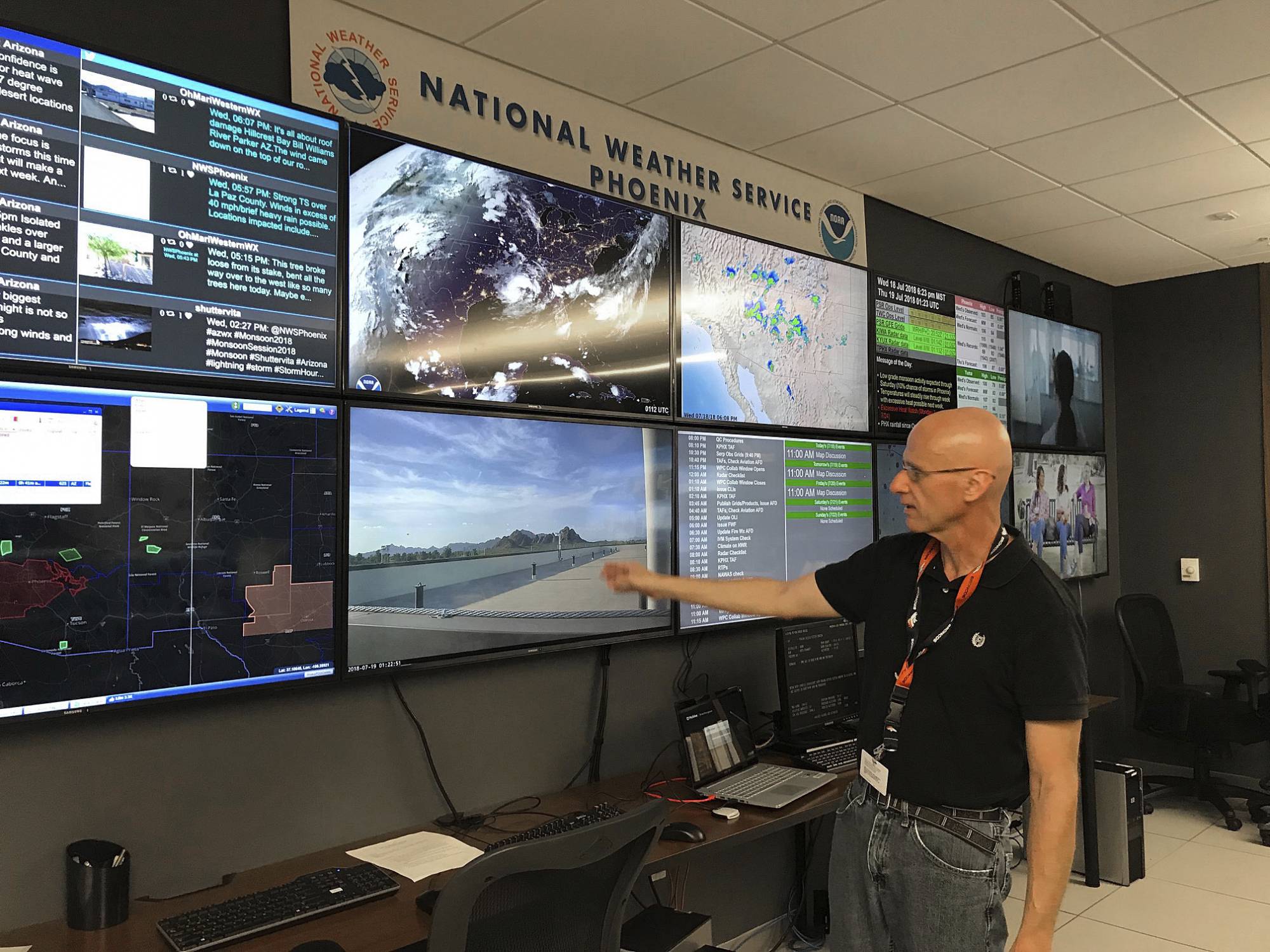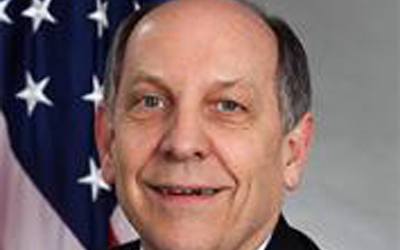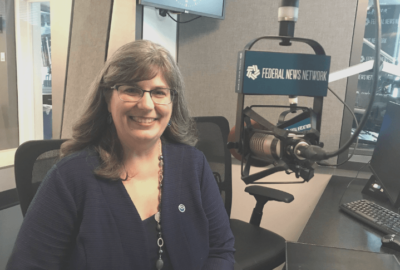

Dr. Louis Uccellini has spent more than 40 years as a federal weather practitioner, first at NASA and then at the National Weather Service, where he's been the...
Best listening experience is on Chrome, Firefox or Safari. Subscribe to Federal Drive’s daily audio interviews on Apple Podcasts or PodcastOne.
You can’t overestimate how much people care about the weather. And although most people may not realize it, the National Weather Service is the original source of most weather forecasts. Our guest has spent more than 40 years as a federal weather practitioner, first at NASA and then at the National Weather Service, where he’s been the director since 2013. Now Dr. Louis Uccellini has announced his retirement. He talked to Federal Drive with Tom Temin about his career and the current state of weather forecasting.
Interview transcript:
Tom Temin: Dr. Uccellini, good to have you on.
Dr. Louis Uccellini: Oh, glad to be here.
Tom Temin: And it’s safe to say that you’re not really as old as weather itself, correct?
Dr. Louis Uccellini: [Laughing] I’m still feeling young, that’s what counts.
Tom Temin: And you’re leaving, and of course, weather is changing and climate is changing, they say, but what would you say is the biggest change in the way weather data and forecasts are generated, that you’ve seen over these 40 years?
Dr. Louis Uccellini: Well, there’s been a lot of changes in the meteorological community and a lot of changes with respect to how observations are made, how forecasts are made from those observations, and then how the forecast and warnings are delivered. So the changes have been actually enormous over the past 50 years.
Tom Temin: And is it changing? The idea of the federal government pretty much having a monopoly on the raw data from satellites and other observation stations, of course, weather services, probably NOAA, which has ships and so on. But that’s changing, isn’t it?
Dr. Louis Uccellini: Yes. And it’s changing for the good. One of the major changes that’s occurred, while over the last 50 years, especially over the last 30 or so, has been the growth of the private sector in their role across the entire value chain. So observations, collecting, making forecasts and warnings, and disseminating those to customers in a very tailored form for specific decisions made by those customers. So yes, they become a very important part. And we support that. The fact is, we can’t do it all, we cannot meet all the demands, and the increasing demands for weather, water, climate information. And there are specific elements that the private sector has really latched on to, and provided the tailored information that’s essential for their decision. So we work in partnership with them. We provide. But we also collaborate, ensure that, to the extent possible, we have a consistent message going out, especially during these increasingly extreme weather and water events.
Tom Temin: And although people complain, it’s a demonstrable fact that the accuracy of forecasts, especially in the one to three day range, has really markedly improved in the past number of years. What has been the driver there?
Dr. Louis Uccellini: The forecasts have improved, actually, in some cases, all the way out to week one for these extreme events. And we’re actually making those forecasts with increasing confidence. These are, you know, the hurricanes we see forecasts made out to day seven now in experimental basis, but we provide information and decisions are being made in that timeframe. Heat waves, even in precipitation events, we can’t make a perfect forecast and there are always times when situations arise where the accuracy is actually even at day one a challenge. We call this the predictability issue. There are science aspects that are actually being studied with respect to that. But enlarge measure, we are improving the forecast and we’re extending the useful forecast out beyond days five, six and seven for a number of these events.
Tom Temin: And do you envision each individual, say being a sensor, now that we have all these smart devices?
Dr. Louis Uccellini: Yeah, that’s an interesting comment. People with their cell phones, taking pictures of potential tornadoes developing and hitting the ground, and sending to us is becoming a very important data source for calibrating and verifying a second source of information that we would be looking at a radar and saying, is that signature we’re seeing in the radar, is that tornado actually forming? And then we get pictures from people with their cell phones. So in that regard, it’s true. Yeah, there’s increasing information out there that we’re tapping into throughout, again, the value chain, that’s helping us and helping what we call the enterprise, which is the public private sector that you refer to before.
Tom Temin: We’re speaking with Dr. Louis Uccellini, director of the National Weather Service, he’s going to retire on Jan. 1. And talking about the NWS as a federal agency, you have had a program called Evolve to kind of modernize the agency. Tell us where that stands now and what you hope the agency will look like when the Evolve program has evolved.
Dr. Louis Uccellini: Well, the Evolve, the word itself, it’s a slow change. It’s working towards a more complex system that we have. Because what the fundamental change we’re talking about here is we’re going beyond the forecast and warning, right? That’s been our comfort zone — development of the models, the physical processes that we study. As we become meteorologists, we apply it to forecasts and warnings. We’re going beyond that. We’re now taking these forecasts and warnings, working with social scientists in terms of how to communicate the calls to action when these forecasts and warnings involve extreme events, and then working with decision makers at every level of government — federal, state, local — so that we get the decisions that we all would want with respect to an oncoming extreme event that, again, there’s uncertainty in the forecast. So we have to work with these folks in emergency management, public safety communities to get the right decisions that citizens can then be directed or they can work with the local officials to decide, are they going to evacuate or not, right? Take cover now, kind of thing. So to get beyond that, to get beyond the physical aspects and get into the human behavior, the human factors, the social science, that’s a slow process. But we’ve been successful over the last decade now in providing a firm foundation for that, and we’re already seeing results. But there’s still a lot more to be done across all 11 service areas that we work on on a daily basis.
Tom Temin: So this is an ongoing effort you feel will continue under your successor.
Dr. Louis Uccellini: Yes, in fact, what we’ve done and what we’ve decided as an executive council within the weather service, this involves more than me, it involves the whole workforce. I mean, the workforce has really embraced this effort. We provide this Impact-based Assistance Support Services, that’s the link to the decision makers. We have now built that into our mission statement. So that it’s not just providing observations, forecasts and warnings, it’s providing observations, forecasts and warnings, and Impact-based Assistance Support Services for the protection of life and property. You have to have that. Everybody recognizes that within the weather service, within NOAA, on the Hill. I mean, this was written into the Weather Act in 2017. So, this is really a fundamental change that we have evolved into. And we’re still learning and we’re still working down this process with our partners, our core partners, to ensure that we’re ready for these extreme events as they come at us.
Tom Temin: I guess it would be a great plan to have the supply chain folded into all of this, because people tend to rush to buy supplies when they think it’s going to rain or snow too much. And then you’ve got these issues of shortages or empty shelves, and so on. So maybe that could be part of the planning also.
Dr. Louis Uccellini: Well, it is. Actually we’re seen that, where people in the different sectors actually work with either their own meteorologist, or again with the private sector, or rely on our forecast, are taking actions. And I’ve seen examples in upcoming snow events where at the beginning of the week, the retail industry has moved their sales from Friday and Saturday to a Wednesday, Thursday because we’re predicting a big storm for Friday and Saturday. So they adjust, right, to take advantage and then not get stuck with all this merchandise on their shelves kind of thing, much less, I’ve seen advertisements now for supermarkets ahead of snowstorms, hey, we’re stocked. So the point is, we’re seeing that, and a lot of these big retail outlets have access either to a private sector group, or have their own meteorology groups now. And what’s really interesting is that some of these big box stores out in the rural areas actually become the central point for shelters, right? They look to be the firmest structure around. And a lot of people now go to a Walmart or Lowe’s, I’m certainly reluctant like them to name outlets, because you got to name them all. What’s ever out there, they are now preparing themselves for the fact that 200 people can show up at their front door looking for shelter as a tornado is coming over the hill. So the point is, this effort doesn’t just involve the meteorologist as evolve effort, it involves people who have to make decisions in the face of an oncoming extreme event. Look at the heatwave out in the Northwest, they set up cooling centers in a number of these places to try to deal with this unprecedented heat. So yes, this is a big effort. It involves the weather service at its core. But it also involves a large segment of the enterprise and now private sector folks, emergency managers, public safety officials, nonprofits, everybody who can help a community get prepared for and respond to these extreme events.
Tom Temin: And let’s talk about your career for a moment. What has sustained you these 40 some years? Is that the weather? Is it federal service, or is it a combination of both?
Dr. Louis Uccellini: Both. Well, actually, I’ve been reading about this and people have actually come up to me and tell me that I love what I do. And that’s a true statement. I’ve always loved the weather. I’ve always been interested in it. Did a lot of research before I came into the weather service. Not only did I get all my degrees at the University of Wisconsin, and be writing papers at the same time, but then I’ve joined NASA for 11 years and was the section head for meteorological analysis and modeling section. I always loved that. I love the research. I love the right. But I was interested in how our work related to forecasting for the public, always. So when the time came, opening came up with the weather service right at the front end of their modernization, very famous modernization associated restructuring […], the Doppler radars and all the restructuring out in the field, degreed meteorologist in the forecast offices dealing with the tornadoes and flash flood. That’s when I joined the weather service. And I wanted to make a difference with the work we were doing, the research we were doing, in terms of getting that into operations, but also learning from the operational people. And what we really need to do to move sort of like ball down the field, because at the time, people weren’t using the information for critical decisions the way they’re using it now. And I would say that that difference in a large measure is a reflection of not only the effort on my behalf, but how the workforce in the weather service in the whole enterprise has embraced the fact that what we do is important for public safety and for the commerce of this country. And we work together to serve those interests and make sure that the information is used as correctly as possible to save lives and property and enhance the national economy at the same time.
Tom Temin: And something tells me that when you retire, you won’t be the type of guy that just puts your feet up and watches the sunset. Maybe you can’t watch a sunset without thinking about the analysis of it. What will you do?
Dr. Louis Uccellini: I love nature too and I do watch the sunset, I have a tremendous number of sunset pictures. But…I’m going to rest for a while and it’s actually been, I’ve been on the go for about 50 years, actually, if you count time at the university where I was working on the degrees, but was also involved in a national project and writing papers. So I really feel like I’ve been on the go for about 50 years, take a little bit of a rest, but, I’m still interested in what’s going on.
Tom Temin: Dr. Louis Uccellini is director of the National Weather Service, he’s going to retire Jan. 1, thanks so much for joining me.
Dr. Louis Uccellini: Glad to be here.
Copyright © 2025 Federal News Network. All rights reserved. This website is not intended for users located within the European Economic Area.
Tom Temin is host of the Federal Drive and has been providing insight on federal technology and management issues for more than 30 years.
Follow @tteminWFED



